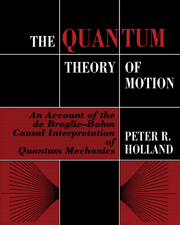 The Quantum Theory of Motion
The Quantum Theory of Motion Book contents
- Frontmatter
- Contents
- Preface
- 1 Quantum mechanics and its interpretation
- 2 Hamilton–Jacobi theory
- 3 Elements of the quantum theory of motion
- 4 Simple applications
- 5 Interference and tunnelling
- 6 The classical limit
- 7 Many-body systems
- 8 Theory of experiments
- 9 Spin ½: the Pauli theory
- 10 Spin ½: the rigid rotator
- 11 The Einstein–Podolsky–Rosen experiment and nonlocality
- 12 Relativistic quantum theory
- References
- Index
12 - Relativistic quantum theory
Published online by Cambridge University Press: 20 January 2010
- Frontmatter
- Contents
- Preface
- 1 Quantum mechanics and its interpretation
- 2 Hamilton–Jacobi theory
- 3 Elements of the quantum theory of motion
- 4 Simple applications
- 5 Interference and tunnelling
- 6 The classical limit
- 7 Many-body systems
- 8 Theory of experiments
- 9 Spin ½: the Pauli theory
- 10 Spin ½: the rigid rotator
- 11 The Einstein–Podolsky–Rosen experiment and nonlocality
- 12 Relativistic quantum theory
- References
- Index
Summary
Problems with the extension to relativity. The Klein–Gordon equation
The attempt to extend the causal interpretation to cover relativistic quantum mechanics raises several problems of technique and principle. These relate not only to difficulties peculiar to the quantum theory of motion but have to do with still unresolved issues in the underlying quantum mechanical formalism (such as the appearance of infinities in the computation of physical quantities and the lack of a relativistic theory of measurement). Some problems are common to both, such as the difficulty of defining positive densities. The subject has not been extensively investigated and in this chapter we shall discuss only some of the relevant issues. There are two particularly important, overlapping problems: Can the trajectory concept be retained in the relativistic quantum domain? And: how do we interpret relativistic quantum fields?
The unresolved issue underlying both questions is the extent to which we should require a quantum theory to be ‘relativistic’. It is known that Lorentz covariant wave equations can have consequences in conflict with relativity. This, as we shall see, is indeed the case with the current relativistic formalism as interpreted, or completed, by the quantum theory of motion. Especially in field theory, the individual processes that build up and explain the covariant statistical predictions of the formalism exhibit features that are in conflict with our entrenched ideas regarding covariance and locality as necessary concomitants of relativity theory. That is, relativity is statistically valid but the individual events do not have an intrinsically relativistic character.
Information
- Type
- Chapter
- Information
- The Quantum Theory of MotionAn Account of the de Broglie-Bohm Causal Interpretation of Quantum Mechanics, pp. 498 - 571Publisher: Cambridge University PressPrint publication year: 1993